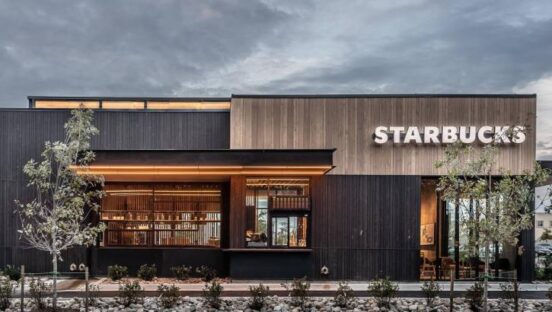Starbucks in November outlined a path to reach 55,000 stores by 2030—a goal that would tack on roughly 17,000 net units within the next six years, or an average of eight new stores per day. As of October, the brand boasted 38,038 locations globally, with a projection of 41,000 or so by the end of its fiscal calendar (this coming October). The near-term goal would be 7 percent new store growth next year—75 percent of which will come outside the U.S. To circle that second point, Starbucks opened about 9,000 shops in the past five years. Of those, 7,000 debuted outside the U.S.
Generally, Starbucks’ international story unfolds most notably in China. At the end of Q4, Starbucks touted 6,806 China locations following record-busting growth of 362 net locations, giving the brand 13 percent expansion, year-over-year—well on its way to Starbucks’ previously defined target of 9,000 China venues by 2025. Getting there would require 1,000 net new units every year. Meanwhile, Starbucks domestic footprint is tracking to eclipse 16,300 restaurants in fiscal 2024.
THE NUMBERS: Starbucks was the fastest-growing brand in America last year
On Tuesday, the java brand publicly added large-scale expansion in India to this ambition. Partner Tata Starbucks Private Limited announced its aim to operate 1,000 stores in the country by 2028. That calculates to a new store opening every three days for four straight years.
Starbucks said India is “at an inflection point,” and projected to become the world’s third-largest economy by 2023, according to forecasts.
The joint venture between Starbucks and Tata Consumer Products Limited is a 50/50 deal that launched in 2012. Tata Starbucks has since opened 390-plus units across 54 Indian cities, employing about 4,300 workers.
Reaching 1,000 shops will double that force to 8,600 as Starbucks plans to enter Tier 2 and 3 Indian cities, expand drive-thrus, airports, and its 24-hour store footprint, it said. Tata Starbucks claims to be the first food and beverage company in the market to have established a five-day workweek, and a third of its current employees were promoted from within.
“Over the past 11 years, the India market has grown to become one of Starbucks fastest-growing markets in the world,” CEO Laxman Narasimhan said in a statement. “With a growing middle class, we are proud to help cultivate the evolving coffee culture while honoring its rich heritage. With our trusted business partner, Tata, and our green apron partners, we are well-positioned to capture the limitless opportunities as we open one store every three days in India and further our aspiration to become truly global.”
READ MORE:
Starbucks Wants 55,000 Shops, and It Will Cut $3 Billion Along The Way
Starbucks and the Coffee Sector are Buzzing
Starbucks New CEO: We Will Deliver Connection
Howard Schultz Steps Down from Starbucks’ Board of Directors
The growth will include another high-end Reserve store to join the one in Fort Mumbai that opened in 2022. Additionally, Starbucks Reserve whole bean coffee Monsooned Malabar from India will be available both at Starbucks Reserve stores in India and the U.S. later this year.
“Tata Consumer Products and Starbucks have enjoyed a remarkable journey, elevating India’s coffee culture and craftsmanship rooted in high-quality Indian arabica coffee beans,” Sunil D’Souza, CEO and managing director at Tata Consumer Products, added in a statement. “As we move into the next chapter of growth, we will continue to develop India’s coffee culture to deepen connections with our customers, while innovating to bring our unique Indian offerings to the global stage.”
The India news is the latest phase in Starbucks’ “Triple Shot Reinvention” plan unveiled three months ago. Alongside reaching 55,000 locations, the company said it would generate $3 billion in savings over three years and double income for hourly employees by the end of fiscal 2025 compared to fiscal 2020.
Part of the growth will include varied store models, from pick-up, drive-thru only, double-sided drive-thru, and delivery-only. “To capture that demand we will build more new stores—with new formats, in new cities and cities we’re already in. To be clear, Starbucks has not saturated the U.S. market,” EVP and president of Starbucks North America Sara Trilling said at the time.
The $3 billion efficiency program noted $2 billion would come outside the store in cost of goods sold. These funds would be reinvested into the business and used to deliver returns to shareholders.
Starbucks also hopes to double its 75 million global rewards members within five years. The chain posted a record-breaking period in Q4 as its fall menu launch led to water mark average weekly sales (including the sixth-highest sales week ever), fueled by a healthy mix of ticket and transaction growth. Ninety-day active Starbucks Rewards members reached 33 million and set records in spend per member and total member spend.
U.S. same-store sales grew 8 percent in Q4 thanks to 6 percent average ticket and 2 percent transactions. International comparable store sales increased 5 percent, led by a 6 percent uptick in transactions and a 1 percent drop in average ticket.
Total company revenue hit a record $9.4 billion, representing an 11 percent increase year-over-year. Full-year revenue came in at $36 billion, or 12 percent growth, year-over-year.
Starbucks projects fiscal year 2024 global comp growth to be 5–7 percent. The same goes for the U.S. market.








